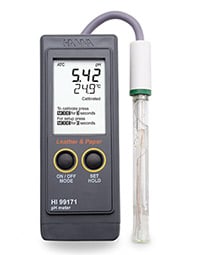
During the American Gold Rush in the mid-1800s, a need for rugged, long lasting clothing arose. As a result, denim was first used in clothing production. Denim is an extremely durable material, holding up in the harshest of environments. Due to its resilience, denim gained widespread popularity; even polo players began to adopt denim jeans, as they would often ride through thick brush and tear their clothing.
Through innovation, denim continued to improve in quality and appearance. The fad of denim jeans grew not only with workers and sportsmen, but spread to the general public. When actors, actresses, and models started wearing denim, the fabric sales took off. Denim is one fashion trend that has stuck around and shows no signs of disappearing.
Denim acquires its color from dye derived from indigo, an organic compound with a blue color. During the dyeing process, the measurement of pH is critical. The pH of the dye bath dictates how deep the dye penetrates into the cotton fabric; the higher the pH, the deeper the dye penetrates. When striving for a deep blue color, a higher pH is maintained in the dye bath; when a "stone-washed" look is desired, a slightly lower pH dye is used in the dyeing process. By controlling and monitoring the pH of the dye bath, denim manufacturers are able to get a specific look in their jeans.
After the dyeing process, a pH measurement of the final product can be used to ensure all chemicals have been thoroughly rinsed from the fabric. Dye baths utilize aggressive alkaline (>pH 9) chemicals that must be rinsed from the final clothing items, as they come in direct contact with the consumer’s skin. If the clothing has a pH outside of the ideal range of pH 4.5 to 7.5, it can result in skin irritation or itchiness. The pH of garments is commonly reported in compliance with the ISO 3071 standard method. This method provides a detailed procedure for the determination of pH in textiles using an aqueous extract solution.
A denim manufacturer contacted Hanna Instruments to test the pH of their finished product. They were currently using controllers to monitor and adjust their dye baths, but wanted a new, portable meter to monitor their finished product as well. When they spoke to their local sales representative, a flat tip electrode was suggested to directly measure the surface pH of the finished denim. Hanna Instruments recommended the Leather and Paper pH Portable Meter - HI99171.
The HI99171 comes equipped with the Flat Tip pH Electrode for Skin and Surfaces - HI1414D with a built-in temperature sensor. The customer worked with the Hanna Applications Department to conduct preliminary testing of the denim’s surface pH, as this method varied from their current standard operating procedure based on ISO 3071. The customer was satisfied with the surface pH results obtained, and were pleased they could use direct measurement as a quick check. Their new procedure for direct measurement allowed them to obtain results must faster than the aqueous extract method, which requires a two-hour extraction time.
The HI99171 pH meter features the ability to perform a two-point calibration at pH 4.01 and pH 7.01, enabling the customer to bracket their ideal pH range of pH 6.0 to 7.0. The glass body design of the HI1414D contributed to the fast electrode response time, as glass reaches thermal equilibrium more quickly than plastic.
Also, included with the HI99171 kit was the HI70960 Preparation solution for solid or semi-solid samples that could be used to perform aqueous extractions in compliance with ISO 3071 for their HACCP reporting purposes. The customer was very happy with the ease of use, accuracy, and support Hanna provided to ensure they were getting the correct meter for their analysis.
That's why we've dedicated our blog as a helpful resource for you to use! Catch up on the latest products, explore industry trends, discover testing tips, learn how to improve results, and more. Got questions? Email sales@hannainst.com.

